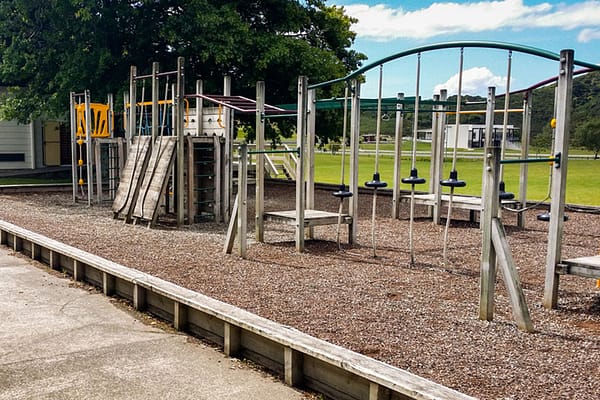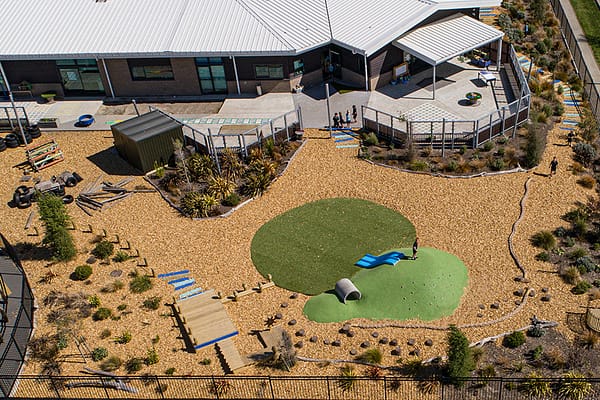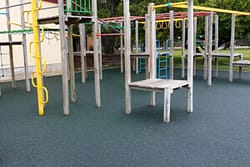When we talk to schools about what they want to do with their outdoor spaces, most say they would like to add or upgrade a playground.
However, recently, a lot of forward-thinking schools are embracing the concept of playspaces. But, what’s the difference between a playspace and a playground? This post will walk you through it.
First, we’ll talk about the more traditional playground.
 Traditional playgrounds
Traditional playgrounds
Traditional school playgrounds tend to have the following characteristics:
- Consist of a few large structures such as towers, climbing nets, swings, and monkey bars.
- Place a heavy emphasis on physical activities such as climbing, swinging, and sliding.
- Make extensive use of loose-fill safety surfacing such as woodchips, bark, and pea-gravel.
Large play structures provide a focal point for a playground; however, they can be expensive and often only provide a few activities. We have witnessed firsthand schools, who have spent the bulk of their playground budget on a large play item, who were later disappointed to discover that only a few students could use it at a time.
Focusing on offering only a few play types often leads to students becoming bored with the playground and is, in our opinion, a missed opportunity to introduce variety to your school playground.
Loose-fill surfacing, while great for safety, can make the play area inaccessible for students in wheelchairs or with mobility issues.
 Transforming your playground into a playspace
Transforming your playground into a playspace
Rather than just building a traditional playground, we advocate for designing and constructing a playspace where there is a balance between traditional and modern play features. When done well, playspaces ensure that students get a greater range of play options, that play is evenly distributed throughout the site, and that areas for learning are also incorporated within the space.
Playspaces usually combine smaller single pieces of play equipment that link the space together. The pieces can be anything imaginable, from cars, to play huts, to a mound slide, to loose-parts play. Usually, they are selected to ensure a range of different play types are provided that help develop gross and fine motor skills, imaginary play, interactive play, sensory play, sporting, social and collaborative play, as well as quiet and singular activities.
In order to move from the traditional playground towards the more modern playspace, schools embrace the concepts of unstructured play and diversity of play type. Today, schools focus 90% on creating playgrounds and 10% on creating playspaces. We believe those ratios need to flip.
Playgrounds vs Playspaces
Playgrounds |
Playspaces |
|---|---|
 Focus on a few large play structures with a limited number of play options. Focus on a few large play structures with a limited number of play options. |
 Focus on providing diversity of play through many smaller play items – climbing, running, jumping, sliding, swinging, water play, creative, musical, social, theatrical. Emphasis on unstructured and open-ended play. Focus on providing diversity of play through many smaller play items – climbing, running, jumping, sliding, swinging, water play, creative, musical, social, theatrical. Emphasis on unstructured and open-ended play. |
 Activities concentrated in one area, catering to a few students at a time. Activities concentrated in one area, catering to a few students at a time. |
 Play is spread out across the playspace and caters to more students. Play is spread out across the playspace and caters to more students. |
 Emphasis on physical play. Emphasis on physical play. |
 A balance between physical, imaginative, social, and unstructured play. Spaces encourage socializing, exploration, and learning. An emphasis on accessibility and making play available to everyone. A balance between physical, imaginative, social, and unstructured play. Spaces encourage socializing, exploration, and learning. An emphasis on accessibility and making play available to everyone. |
 Single-purpose space. Single-purpose space. |
 Multi-purpose spaces that accommodate a range of activities such as play-based-learning areas, outdoor classrooms, and parent gathering areas. Multi-purpose spaces that accommodate a range of activities such as play-based-learning areas, outdoor classrooms, and parent gathering areas. |
Ultimately, playspaces seek to maximise the play value per metre across your site. They do this by diversifying the types of play on offer, optimizing their placement throughout the site, and ensuring there is a balance between the various play types.
